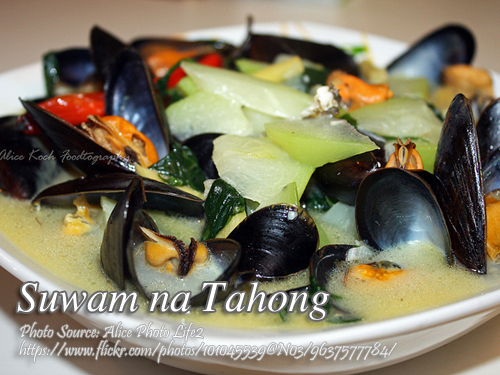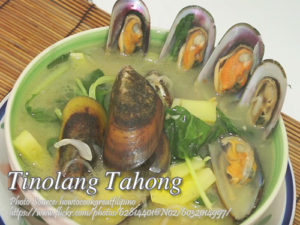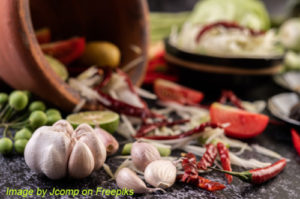There is a big similarity between suwam na tahong and tinolang tahong because they used unripe papaya for the vegetable and it is also a soup. As much as possible, make sure that the mussels are fresh and alive because they smell awful and unhealthy to eat when shellfish are dead. Beware also of the red tide. But don’t worry it doesn’t occur often and you will hear the news. You might wonder what is the rice water? you can get it by washing the rice but throw away the first rice washing. Then save the second and third for this recipe.
Suwam na Tahong – A Comforting Taste of Home
There’s something about a warm bowl of suwam na tahong that brings back memories of home. I remember how my Tita Linda, the best cook in our family, would prepare this dish on rainy afternoons. She’d hum an old kundiman tune while carefully washing the mussels, her hands moving with the ease of someone who has cooked this dish countless times before.
She always said that the secret to a good bowl of this comforting stew was patience—taking the time to clean the shellfish properly, using the right kind of unripe papaya, and never rushing the broth. The result? A light yet flavorful soup that warms not just the stomach but also the heart.
What Makes Suwam na Tahong Special?
This dish bears a striking resemblance to tinolang tahong, as both are soupy and use unripe papaya. But what sets it apart is its simplicity and the use of rice washing as the base for the broth. Unlike regular water or stock, rice washing (or hugas bigas) adds a slightly starchy richness to the soup, making it extra comforting.
When my Kuya Ramon was still living in Cavite, where mussels are plentiful, he’d tell me stories of fishermen bringing in fresh shellfish early in the morning. He learned from an old manang at the market that you should always buy mussels that are tightly closed—this means they’re still alive and fresh. Any open ones should be discarded because they might already be dead, and eating them could be unsafe.
How to Prepare the Mussels Properly
I learned from Lola Belen that the key to a clean and grit-free dish is soaking the mussels in salted water. She’d pour just enough water to cover them, add a teaspoon of salt, and let them sit for at least an hour. This trick helps expel the dirt and sand trapped inside the shells.
Once soaked, a good rinse and a light scrubbing ensure that they’re ready for cooking. If you skip this step, you might end up with a sandy broth—something no one wants in their suwam na tahong.
Building the Flavors with Simple Ingredients
Like most Filipino stews, this dish starts with a fragrant base of sautéed garlic, ginger, and onions. I remember Nanay telling me that browning the garlic first gives the dish a deeper, almost nutty aroma. Once the ginger turns golden, you add the onions and cook them until soft. This layering of flavors is what makes the broth so inviting.
The next step is adding patis (fish sauce), allowing it to infuse the aromatics with its umami depth. After a few minutes, in goes the rice water and the papaya.
Unripe papaya is a crucial ingredient. It has a mild taste but absorbs the flavors of the broth beautifully while adding a slight sweetness. My cousin Jenny once tried substituting it with chayote, and while it worked in a pinch, she admitted that nothing quite compares to the traditional use of green papaya.
Bringing It All Together
As soon as the papaya starts to soften, it’s time to season the broth with a little salt, pepper, and vetsin (MSG), a well-loved flavor enhancer in many Filipino households. Some might skip it, but Tatay always insisted that a pinch made the broth taste more balanced.
Once the flavors have melded, the mussels are added, their shells clinking as they settle into the steaming broth. It only takes a few minutes for them to open up, releasing their natural briny sweetness. Any mussels that remain closed should be discarded—they were likely dead before cooking and might not be safe to eat.
For the final touch, fresh dahon ng sili (pepper leaves) are stirred in just before serving. These tender leaves add a subtle peppery note that ties everything together.
The Comfort of a Bowl of Suwam na Tahong
Whenever I make this dish, I can’t help but think of home. It reminds me of lazy Sunday lunches with my family, when we’d all gather around the table, blowing on spoonfuls of steaming broth and picking mussels straight from the shell.
Historically, mussels have been a staple in coastal Filipino communities, where shellfish are abundant and inexpensive. Our ancestors made the most of nature’s bounty, creating simple yet nourishing dishes like this one. Even today, suwam na tahong remains a favorite among many Filipinos, offering comfort in every sip.
So, if you’re craving something warm, hearty, and deeply nostalgic, try making this dish. Serve it with steaming white rice and a little calamansi on the side for that extra zing. Just like my Tita Linda used to say, nothing beats a home-cooked meal made with love.
How to Cook Suwam na Tahong (Stewed Mussels with Papaya)
Ingredients
- 1 kilo fresh large tahong mussels
- 1 pc large onion sliced
- 2 cups diced unripe papaya
- 4 cloves garlic minced
- 2 Tbsp. ginger strips
- 2 Tbsp. patis
- 1 tsp. MSG or granulated seasoning
- 4 cups rice water
- 2 Tbsp. cooking oil
- 1 bunch chili pepper leaves dahon ng sili
- salt to taste
Instructions
How to cook Suwam na Tahong:
- To clean the mussels, put them on a basin with water just enough to cover the shells. Put a teaspoon of salt. Leave them for at least an hour to expel the dirt and grime. After an hour, wash and drain and set aside.
- Saute garlic until brown. Set aside. Saute ginger until brown then add the onions and saute until soft.
- Add in patis and stir for 3 minutes then add the rice water and papaya. Cover and bring to a boil.
- When papaya is half done, season with MSG, salt and pepper then add the mussels.
- Boil until the shell open up. Lastly add the pepper leaves. Serve hot.
Notes
Cooking Tips:
Properly Clean the Mussels for a Grit-Free Broth
Before cooking, soak the mussels in salted water for at least an hour to help them expel dirt and sand. Scrubbing the shells and rinsing them thoroughly afterward ensures your broth remains clear and free from unwanted grit. Any mussels that remain open before cooking should be discarded, as they might already be dead and unsafe to eat.Use Rice Washing for a Richer, More Flavorful Soup Base
Instead of plain water, use rice washing (hugas bigas) as your broth base to give the soup a light, starchy richness. The natural starches add body to the soup while enhancing its mild sweetness, complementing the briny mussels and tender papaya. Just be sure to discard the first rinse, as it contains most of the dirt and impurities from the rice.Add Pepper Leaves at the Last Minute for Maximum Flavor
Stir in the dahon ng sili (pepper leaves) just before turning off the heat to preserve their vibrant color and subtle peppery taste. Cooking them for too long can make them lose their fresh aroma and delicate flavor. If you can’t find pepper leaves, malunggay or spinach can be a good alternative, though they’ll have a slightly different taste.





